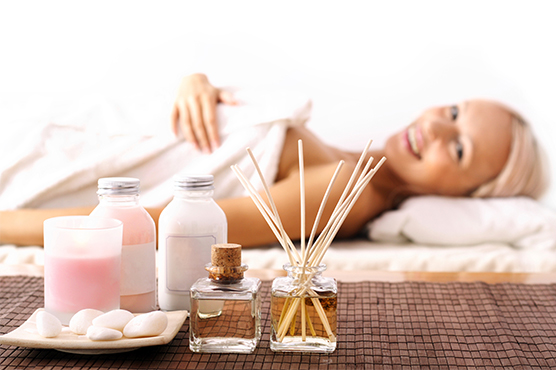There are multiple ways we can benefit from aromatherapy at home. Below are the descriptions of the most common ones.
Bath: a warm bath with essential oils can be a very pleasant and therapeutic experience. We get the benefits by both inhaling the oils and by absorbing them through the skin. It is important to remember that oil and water do not mix, therefore pouring them directly into a bath will result in a film of undiluted oil sitting on top. They will tend to cling to your skin which may turn to be very unpleasant and may bring burning sensations. Therefore well diluting your oils in a carrier oil (such as jojoba, or in unscented shower gel or shampoo) for them to be properly dispersed in the water is essential. You can then blend diluted oils with sea salts for additional therapeutic effects, as we know that baths can relieve a wide variety of conditions such as insomnia, sore muscles, jet lag, etc. If you would like to learn more about the benefits of aromatherapy bath, please visit our Blog.
Footbath: this can be an excellent treatment for sore tired feet, dermatitis and dry skin. The same rules apply for diluting essential oils before adding them to water, as described above. You can find a simple footbath recipe for tired feet on our Blog here.
Steam inhalation: this treatment can be effective for colds and nose congestion, as well as a part of an aromatherapy facial to warm up the skin and to open pores. All you need is a bowl of very hot water (be careful not to spill it!), essential oil(s) of your choice and a large towel. The best choice for colds and sinus congestion would be Eucalyptus Radiata (safe for children of 2 years and older), Ravensara, Niaouli and Hyssop. For the aroma-facial purposes you can opt for Lavender, Chamomile and Rose-Geranium. Add 3-4 drops of oil(s) to a hot water, sit with a head at a comfortable distance from bowl and cover your head with a towel to keep the vapour in. Shut both eyes and breathe deeply with each inhalation lasting 2-3 seconds. Repeat as needed for no more than 5-10 minutes per session.
Diffuser: this is the most common use of essential oils through inhalation. Always follow the manufacturer’s instructions in terms of regular cleaning and drying of your diffuser and the volume of water and essential oils to add. The general recommendation for intermittent use is 30 mins ON, 30 mins OFF. Normally there are no contraindications for pets if you have any, but it is better to always keep the door open for them to leave if they want to (especially cats). The reed diffuser is another good option to always have your room perfumed without the need for regular maintenance: these are liquid air fresheners in a narrow-necked bottle with long “sticks” inserted into the liquid. These sticks, or reeds, absorb scented liquid from the container and release fragrance into the surrounding air. If you purchase the commercial reed diffuser, please make sure it is not made of synthetic material and fragrances that can be harmful for your health. You can also make your own liquid with natural oils.
Inhalation: the easiest way to enjoy and benefit from essential oils is to simply sniff directly from the bottle or put 1-2 drops on a cotton pad and inhale it from there. You can experience instant results as the inhaled molecules enter directly into your brain and the signal for action follows immediately. If you don’t always have your oils at hand, but would like to use them for specific conditions such as hormone balance, anxiety relief, nausea relief, to calm down or to energize yourself, you might want to consider using a personal inhaler, which allows you to carry your special blends with you wherever you go. You can learn more about personal inhalers here.
Scalp and hair treatments: essential oils can be very effective to treat the hair and scalp, for example to strengthen the hair follicles and to get rid of frizzes. A variety of base carriers can be used, such as castor, coconut, jojoba or avocado oils to which the essential oils can be added. The good choice would be Rosemary, Sage, Peppermint and Tea Tree. Here is a simple recipe suitable for all hair types: mix 10 to 20 ml of warm castor oil with several drops of Rosemary essential oil, apply to hair and scalp, cover up and leave for about 1 hour, then rinse well with warm water and shampoo your hair. You can also leave the treatment overnight and shampoo it in the morning (in this case remember to cover your pillow with an old towel).
Home made cleaning products: there are many essential oils with strong antibacterial and antimicrobial properties that can help you keep your home clean in a natural way. You can just add couple of drops of Tea Tree, Eucalyptus and/or Lemon essential oils, for example, into your home cleaning products and soaps, or you can make your own. I share a simple recipe of all-natural multipurpose cleaner in my Blog post here.
And these are just a few ways to enjoy the wonderful benefits of aromatherapy at home. You are welcome to share your own experience in the comments section.
